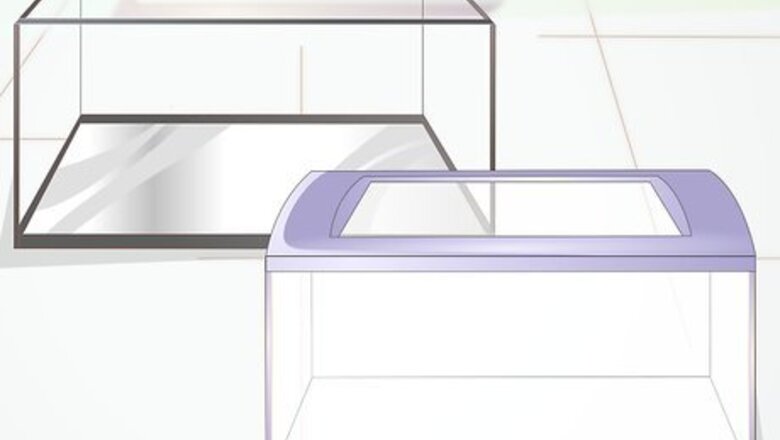
views
Setting Up the Tank and Stand
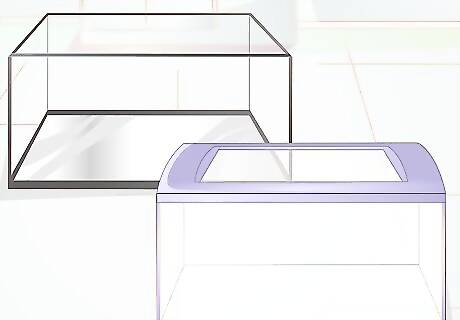
Choose a fish tank. A little forethought can go a long way towards keeping your fish healthy and your aquarium fun to maintain. Do a little research on what kind of fish you want, (described in further detail later in this article) and then select a tank that will accommodate them. The tank you choose needs to be large enough to hold enough water for the type and number of fish you plan to have. Different fish need different amounts of room and produce different amounts of waste. In general, the larger the fish are, the more waste they make and the more water is needed. Keep in mind that live plants and other decorations will also take up space. There exist various calculators to help you decide what fish are safe to keep based on tank size, compatibility, and needs. The one-inch per gallon rule you may have heard is a rule of thumb that scales quite poorly to smaller or larger tanks. You would never keep two five-inch fish in a 10 gallon (37.9 L) aquarium! A 55 gallon (208.2 L) tank is a standard size that will allow you to have a variety of fish. As a beginner, you probably don't want to go larger than this just yet. You could also go with a 20 or 25 gallon (75.7 or 94.6 L) tank for a starter tank and keep just a few hardy fish (Mollies, guppies, platys, tetra, small cory cats and no cichlids) to see if you like the hobby. It is not recommended to start out with anything less than 10 gallons (37.9 L) - meaning no "Desktop" aquariums or the small, single Betta holders. As tempting as it is, it is actually harder to maintain good water quality in a small tank.
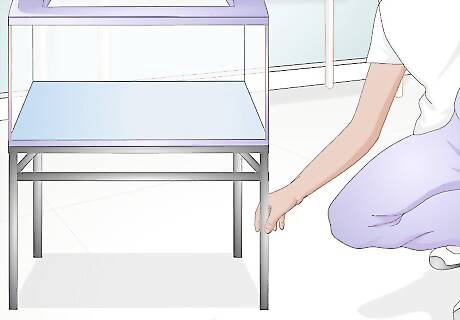
Get an aquarium stand. Aquariums that hold 20 gallons (75.7 L) or more will need a stand no matter what. The only exception is if they are on a heavy, well-anchored counter. Buy one that is designed for the dimensions and shape of your tank. Don't underestimate the weight of a full fish tank! Make sure the stand is either rated for the size of your tank or that it has been custom built to be very sturdy. It is vital to the integrity of the tank it will hold that it be sturdy enough to hold the tank's weight. In addition, it is not safe to have an edge of the tank sticking out over the side. Furniture like dressers, TV stands, end tables/buffets, or flimsy wooden desks aren't strong enough. Look for complete tank kits at those big box pet stores. Used setups from websites like Craigslist are often available for great prices, but be sure to check for leaks and clean very well before use. If you don't buy a complete setup, make sure the equipment you choose is rated for the size of your tank.
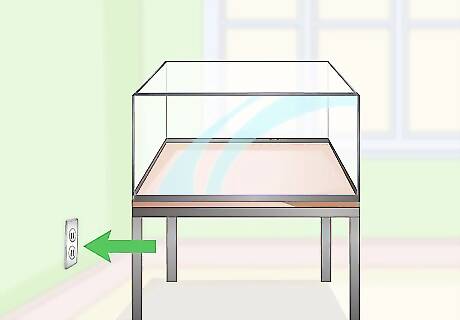
Decide where to put the aquarium and stand. Choosing the right spot is important for the health of your fish. You'll want to put it in a place where the temperature remains pretty consistent and the amount of light doesn't get overpowering. Allow at least 5 inches (12.7 cm) between the wall and the aquarium to make room for the filter. Some things to keep in mind when choosing location for your tank: Too much sunlight will cause excessive algae growth and a maintenance nightmare. An interior wall, away from bright light, is best. Try to stay away from putting the tank under a vent - dust will blow out and drop into the fish tank. It will also be harder to maintain a consistent water temperature, something that is important for all fish but vital for some. It is also important to consider the ability of the floor to support the weight of the fully loaded aquarium. Make sure that there is adequate structural support under the floor. If necessary find your home's blueprints and look for crossbeams. Choose a location near an outlet, and keep in mind how far you will have to haul water for weekly tank maintenance! No cords should be straining to get to the outlet either. In fact, it's a good idea all around to get a surge protector power strip (which you'll love when the power snaps back on after an outage) and go from there. Set up your tank stand ideally on a wooden floor, not a rug or carpet.
Installing the Filter and Adding Gravel
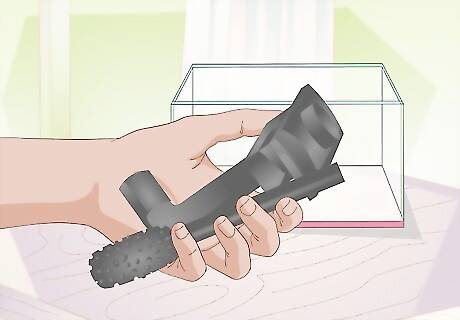
Decide which filtration system you would like to use. The most common and easiest are either under-gravel filters or power filters (recommended for first-time owners over under-gravel filters) that hang on the back of the tank. Don't get caught up in technology. Penguin and Whisper power filters provide both mechanical and biological filtration and are easy to clean and use. Only use Top Fin if you know your way around filters (get a Whisper if you get the excellent Top Fin starter kit). If you choose an under-gravel filter, make sure that the air pump or powerhead you buy with it is strong enough for the size of the tank. In this case, bigger is better. Note that if you don't regularly vacuum the gravel it will eventually clog the under-gravel filter and turn it into a killing zone. Keep in mind that you can't use an under-gravel filter if you plan on having sand or other fine substrates. If you decide to go with a power filter, select one that will circulate enough water for the size of your tank. (Ideally, it should filter your water 5 or more times per hour [gph], depending on your tank capacity. For example, a 10-gallon tank would need a filter that circulates at least 50 gph.)
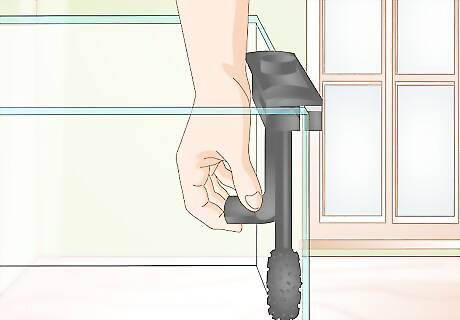
Install the filter. The installation methods vary by the filter. Figure out which one works with the equipment you have: For under-gravel filters put the filter plate in, and make sure the lift tubes are fitted. (If you have a submersible powerhead, you only need one; with a traditional air pump, two are best for most tanks under 40 gals, one at each end.) Do not turn it on until the tank is filled completely with water. Attach your pump airlines or powerhead into the appropriate lift tube(s) now, if you've got an under-gravel filter. Don't turn it on. If you've chosen an external power filter, set it up on the back of the tank in a position where the outflow will evenly distribute the water. Some tank hoods come with pre-perforated cut-outs which make it easier to position your equipment. Do not turn it on until the tank is filled completely with water.
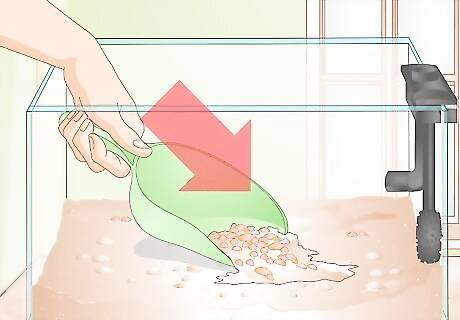
Fill the bottom with gravel. Having about 2 to 3 inches (5.1 to 7.6 cm) of gravel on the bottom is essential to a healthy aquarium and helps fish keep their orientation in the water. Cheap gravel (lots of color choices) can be purchased from pet stores dealing in aquarium products. Sand is optimal for fish and invertebrates that like to burrow but it needs to be stirred on a regular basis to prevent dead spots that can wreak havoc on your tank or ruin a filter. Beginners are better off using gravel. If you are interested in a planted tank, make sure to get an appropriate substrate. Good ones include Amazonia and Azoo substrates. Rinse the substrate in clean water before adding it to the aquarium. The less dust in the water, the faster it'll clear when the filter is started up. This step is especially crucial if you're using sand instead of gravel but remains important for all setups. Wash gravel through and through. Make sure to use no soap - it is very harmful to fish and will kill them. Slope the substrate slightly upward toward the back of the aquarium. If you have an under-gravel filter spread the rinsed gravel in an even layer across the surface of the filter. (Pour in a bit at a time - to allow it to settle the way you want but also because it will scratch the tank walls if you pour it in too fast). Put a plate on top of the substrate so it doesn't disperse when you add water.
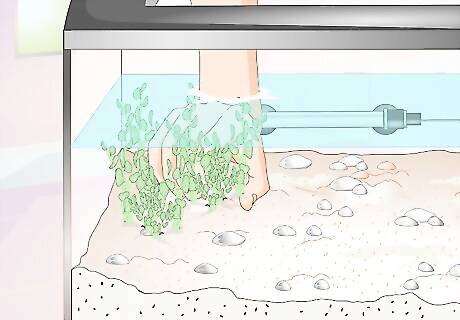
Set up chosen plants and decorations. Make sure you arrange them how you like at this point because once the water and fish are in the tank, you'll want to have as little stress as possible––and that means no hands in the tank. Plants are functional decorations; it is difficult to make a mechanical filter control a plankton bloom, but live plants make it easy. For some fish, plants actually help them stay healthy. However, live plants get gobbled up quickly by some types of hobby fish such as goldfish. Aside from plants, you can add driftwood or other decorations specifically designed for freshwater aquariums. Don't put random objects in the tank. If you use live plants, you'll need to monitor the CO2 level in the tank. Aim to keep the CO2 level around 20-25 mg per liter so your live plants thrive. Choose the plants you need according to what type of fish you're getting. Submerge the roots in the gravel, but not the stems or leaves. Certain plants need to be fastened to something, so get some fishing line (will not hurt the plant or fish) and tie the plant to a decoration or an appropriately cleaned piece of driftwood or rock.
Adding Water and Heat

Look for leaks. Fill the tank with about two inches of water, then wait for a half an hour. If there are any leaks, it's better they show up now, rather than when you have filled the entire thing. If you don't see leaks, fill up the tank about 1/3 full. Do this somewhere where you won't mind water if it does leak. Have sealant on hand so that you can dry the tank and start fixing it.
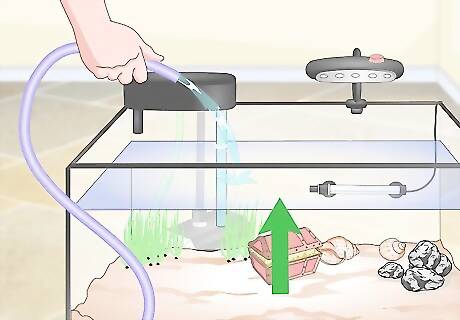
Fill the tank the rest of the way. Once you are sure that all the decorations are just the way you want, fill the tank up to just under the rim of the tank, leaving a gap of 1 inch (2.5 cm).
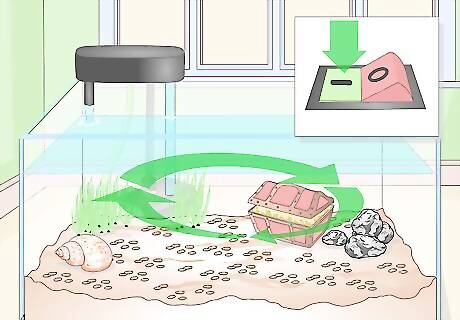
Start the filter. Fill the reservoir of the filter with water, and plug it in! Water should smoothly (and quietly) circulate after a couple of minutes. Plug in the powerhead/pump if you have an under-gravel filter. Water should start moving vertically in the lift tube(s). Wait for an hour or two and check that the temperature is still in the safe range, that there are no leaks, and that the water is circulating properly.
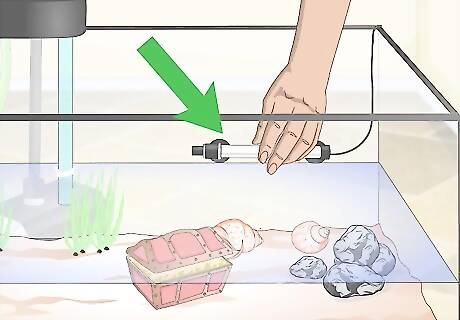
Install your heater on the inside of the tank. It will attach with suction cups. Try to position it near or at the mouth of the filter expelling water. This way the water will be evenly heated. Most of the thermostats on new heaters now come pre-set at an acceptable temperature range of 70-77 degrees Fahrenheit (21-25 degrees Celsius). Plug in the heater and install your thermometer. Do not turn it on until the tank is filled completely with water. The fully-submersible heaters are the easiest to use. Look for one with an adjustable thermostat, since different fish prefer different temperatures. A good rule of thumb is 3-5 watts of heat per gallon of water. Most fish like it between 70 and 80 degrees Fahrenheit. Basically, keep it between 78-82 degrees F. or 28-32 degrees C in a community tank. Some lights (sometimes included in starter kits) put out so much heat that the water temperature will be drastically altered. When it is turned off, the temp. falls drastically as well. Not good for fish. If this happens, simply go to the hardware store and get the kind that doesn't give off such extreme heat. Remember to turn on the heater only after water is added to the tank. Give the heater time to adjust the temperature before cycling the tank.
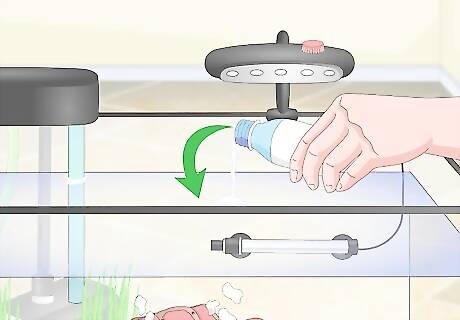
Add water dechlorinator. Tap water contains chlorine and other chemicals that will kill fish, so it's necessary to add a neutralizer unless you use distilled water off the bat. Add the dechlorinator according to the instructions on the bottle. This is also the time to add a starting dose of SafeStart or another bacterial catalyst which will speed up the growth of good bacteria. Make sure to follow the instructions on the bottle closely. The activated carbon of your filter may need to be removed while the chemical circulates, otherwise, the filter may remove it before it has a chance to detoxify the water.
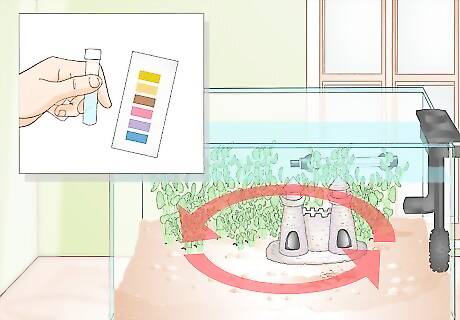
Cycle your tank, preferably for at least a few weeks. For instructions on the fishless cycle (the most humane way to grow the beneficial bacteria all tanks need) see Do a Fishless Cycle. The cycle must be completed before you add any fish to the tank, or they will die. During the cycle, you need to monitor the water parameters (pH, High pH, Ammonia, Nitrite, and Nitrate). When the numbers for Am., Nitrite, and then Nitrate spike and lower to 0, you have completed your initial Nitrogen Cycle and are in the clear to add fish. (To help move Ammonia and Nitrites along, you may have to use Ammonia Remover. The only way to reduce the Nitrates is to do water changes and physically remove the bad chemicals). Remember to continue doing water tests, especially with a new tank. You may need to do daily 15% water changes to keep your fish tank clean, depending on the nitrate levels. Adding live plants will reduce the number of nitrates as well.
Introducing Fish
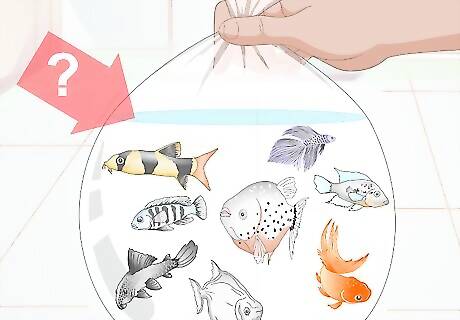
Choose fish. Discuss what type of freshwater, tropical fish you want to have with the salesperson.They should give you tips on which types can and can't get along, and so forth. Look for a locally-owned fish store in the area, since they tend to provide the most accurate information and high-quality fish. Quality pet stores usually have compatibility charts for freshwater and saltwater fish. Although you may see two types of fish you really like, they may not be compatible. The result of bringing them both home would be harassed colorless fish (they lose color when stressed), and eventually the fish that is not the alpha bully will simply die. Why spend the money, right? Often, fish stores will have stickers that indicate whether the fish are "community" fish (highly recommended as they get along with other community fish), "semi-aggressive" or "aggressive". You may mix community fish together, but not a community with semi-aggressive. If this is your first tank, do not get fish that are only recommended for intermediate or experienced aquarium owners. Like owning a dog, there is a reason they are not for beginners. Be aware of the size of the adult fish (not the baby you're getting) and do not get a fish you won't be able to handle down the line. The same goes for freshwater sharks, crabs (who, by the way, try to escape all the time), Cichlids, and animals that bury themselves. It's not fair to the fish. Guppies, platies, swordtails, or mollies are good starter fish. But it all depends on your tank size. If your tank size is 5–10 gallons (18.9–37.9 L), you might get 3-4 African dwarf frogs, or a betta, or possibly a betta and some shrimp. Do lots of research before adding any fish to your tank.Do not only use the 1 inch (2.5 cm) of fish per gallon rule.
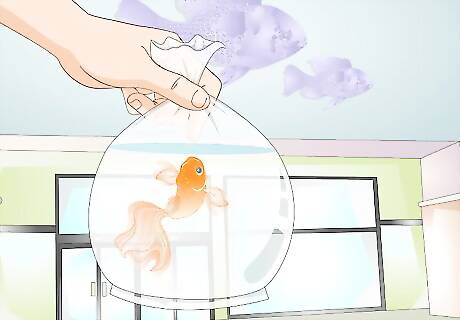
Don't buy all of your fish at once. Know all the fish you hope to eventually have in your fish tank and buy two of the smallest (this goes for all types except for schooling fish, which should be bought in groups of 4 (ideally 6+). You can introduce a new group of fish every 2 weeks. Add the largest fish last.
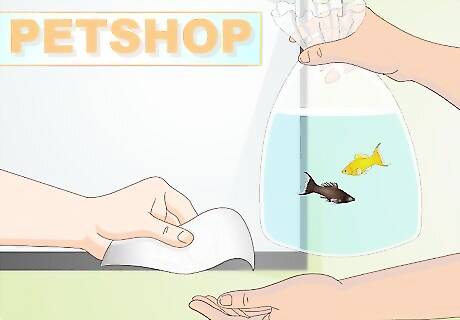
Transport the fish home safely. The salesperson will have filled a plastic clear bag with water, then fish, then blow it up with oxygen. When you get to the car, rest the bag in a place where it won't roll around or have something fall on it. Go straight home. The fish can only survive on the water and oxygen they've been given for maybe 2 1/2 hours. For trips longer than that, different packing procedures should be taken.
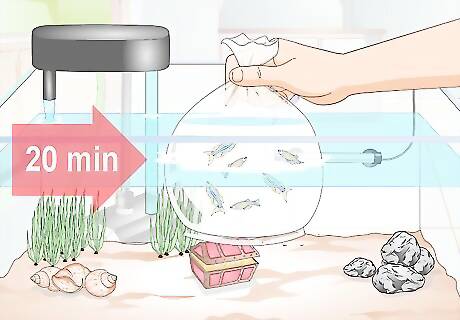
After the pet store worker catches your fish, bring the fish home and set the bag in your tank. Let it sit there for about 20 or 30 minutes. Then open the bag and let some of the water from the tank in. Be sure to not let any water from the bag into the tank! Let it sit for another 20 or 30 minutes. Gently net the fish out and pour all the pet store's water in the sink. Or pour the fish into the net over a bucket and then release into tank. Discard store water. The reason you do not want to add pet store water into your tank is that the store water may contain unwanted contaminants like parasites, fungus, or freshwater snails. Pet stores that cycle their fish rapidly often treat their water regularly for diseases, but in a home tank you will not have the same tools available and an infection or infestation can wreak havoc on your tank's ecosystem.
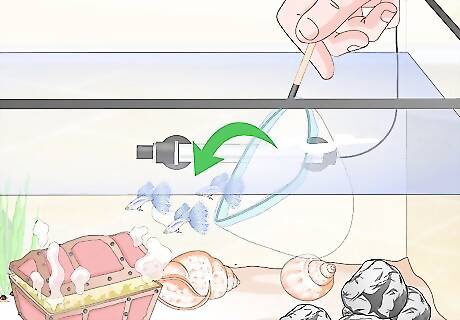
Introduce the fish to your aquarium. Start with two or three fish the first ten days, then get two or three more, wait another ten days, etc. If you put too many fish at once into a new tank, the water will not be able to adequately cycle, and will quickly turn toxic. Patience is the key for the first six to eight weeks. That said, a big mistake people make is to buy schooling fish but only get 1 or 2 of them. This is stressful and cruel for the fish. A school means that a group of 5 is the minimum. A great book for stocking suggestions is "The simple guide to freshwater aquariums by David E Boruchowitz".

















Comments
0 comment